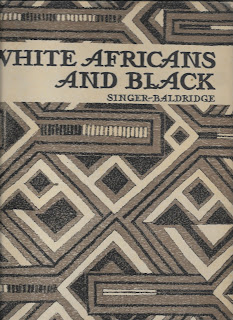One of the first things the authors mention is that photographs do not do justice to the shading and tone of African skin--but their drawings certainly do. The people are all beautifully drawn--very well muscled, graceful, and beautiful. They comment on relations between men and women, slavery (which had been outlawed, but still was obvious), funeral customs, polygamy, religion, the culture of the "Creole" West Indians who had returned to Africa but weren't really African, food, bathing, language, work attitudes.
The illustrator is Cyrus Baldridge, and his wife, Caroline Singer is the writer. Her writing style is unusual. She uses almost no active verbs, lots of descriptive clauses, and sometimes word repetition, and so her writing develops sort of a calming rhythm. I would love to see something else they've written--and they did a lot of traveling,
“Quiet is the bedroom which adjoins our own, occupied by a swaggering hawk-nosed Kissi, his childlike wife and half a dozen retainers who, though slavery is by law abolished, differ racially from their employer and obey him, without servility, but still as people owned obey. That the young man is Moslem is evidence not by robes and sandals alone—for many pagans assume this dress without derangement of their inner life—but by his pretty one’s abasement, which has a subtly meretricious quality. She is demure. But I think she is so designedly, not unselfconsciously as pagan women are. It is often stated by the governing whites—despite the missionary’s protest—that any pagan, Moslemized, has made an upward step. This child, littered with European jewelry of dubious gold, is set apart from other women here by a mincing self-consciousness, equalled only by the preciousness of half-Europeanized women of the larger coast settlements, unduly inflated by newly acquired monogamy, Charleston sandals, and coverings for their upper parts. A favorite toy, chosen for her charms and not her usefulness, the girl, as if in fearful anticipation of the day those charms may pass, undetected from behind her husband’s back, plunges long glances into the eyes of passing men, searching for reaffirmation of their potency.”https://www.lib.uchicago.edu/collex/exhibits/cyrus-leroy-baldridge-illustrator-explorer-activist/
If I were collecting books instead of giving them away, this is an illustrator/author I would try to locate.
https://www.lib.uchicago.edu/media/documents/baldridge-C.pdf
A WWI illustration from “ I Was There With the Yanks In France (1920), a book of sketches by the artist Cyrus Leroy Baldridge, who had served as a war correspondent in occupied Belgium and France before America even joined the war. Baldridge later joined the American Expeditionary Forces (AEF) and became the chief illustrator for the new Stars and Stripes military newspaper.” https://library.wustl.edu/wwi-archives-dan-bartletts-books/







No comments:
Post a Comment